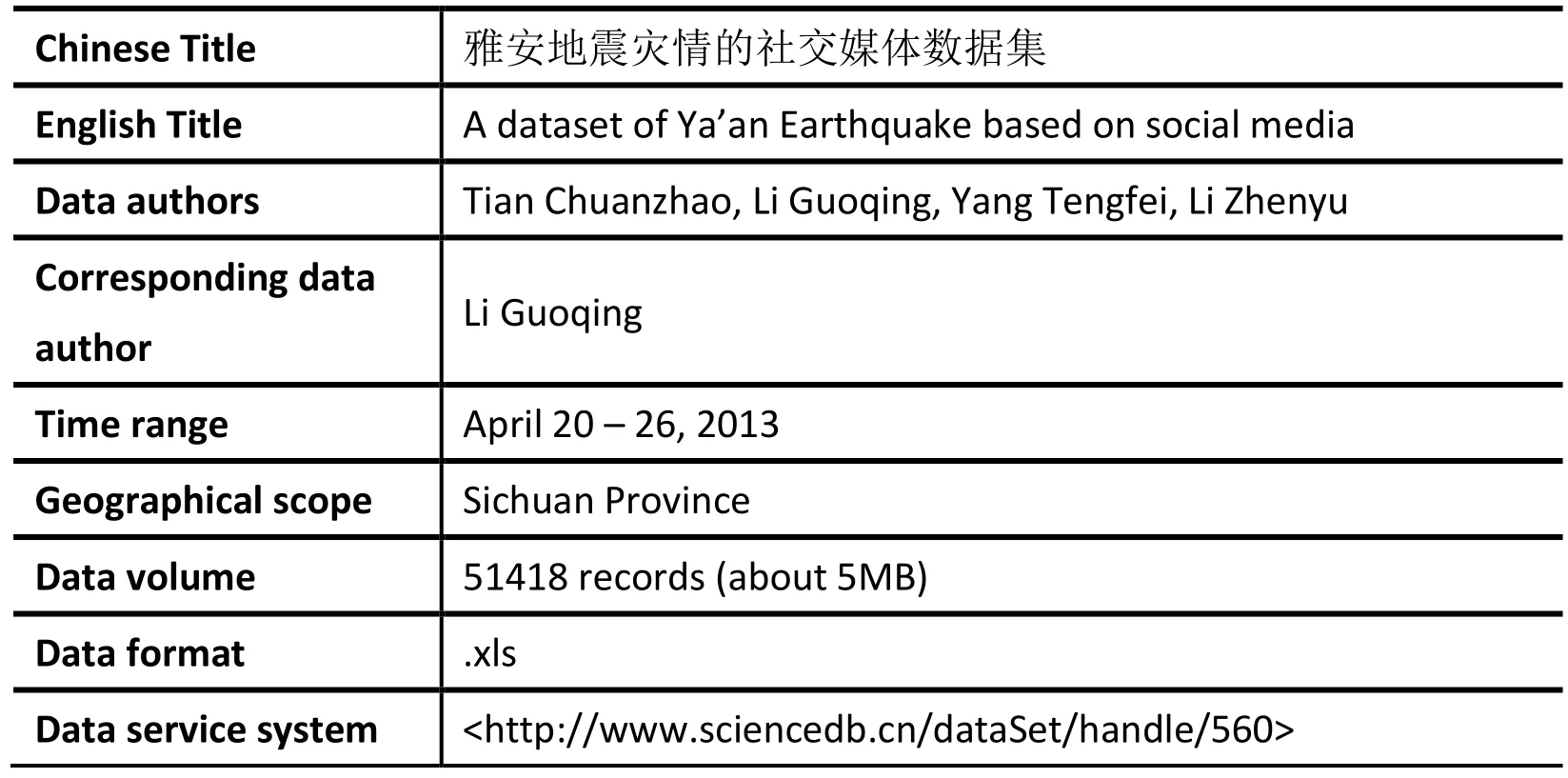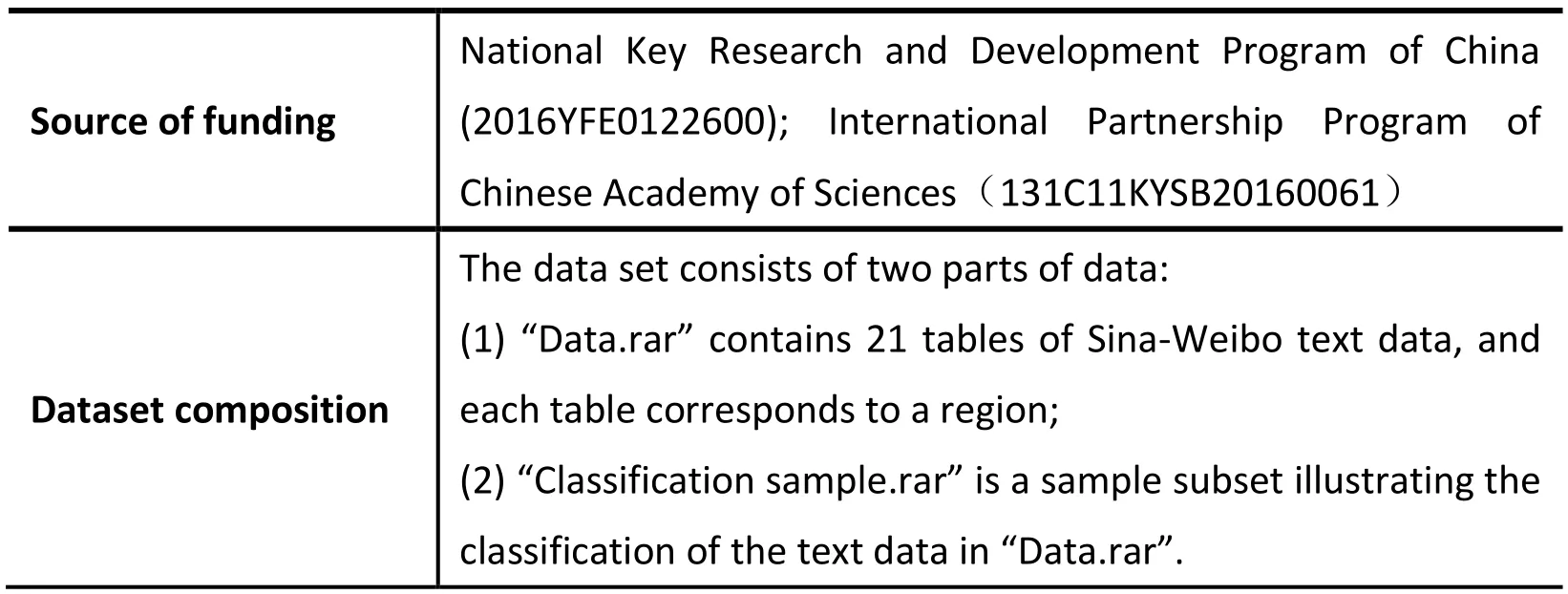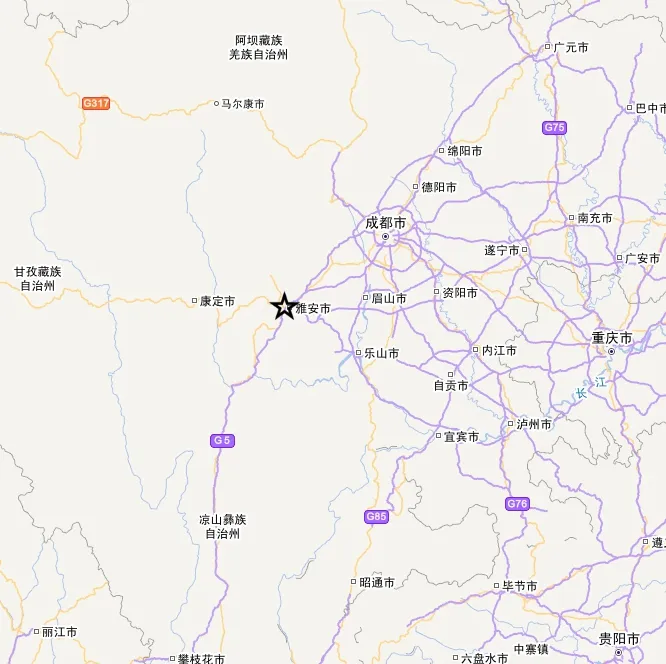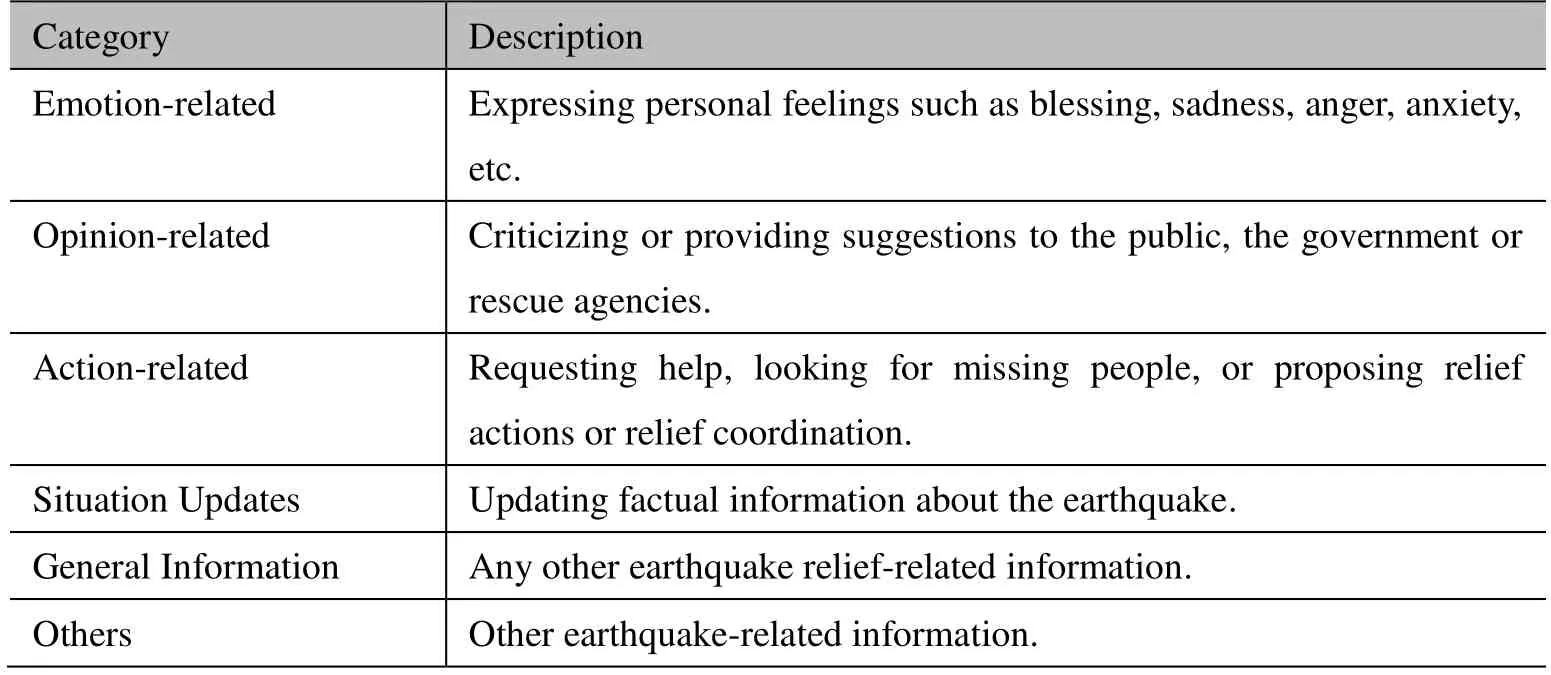A dataset of Ya’an Earthquake based on social media
Tian Chuanzhao, Li Guoqing, Yang Tengfei, Li Zhenyu
1.University of Chinese Academy of Sciences, Beijing 100049, P.R.China;
2.Institute of Remote Sensing and Digital Earth, Chinese Academy of Sciences, Beijing 100094, P.R.China;
3.Shandong University of Science and Technology, Qingdao 266590, P.R.China
Abstract: The Ya’an Earthquake occurred on April 20, 2013 (Beijing time).Its epicenter was located in Lushan County, Ya’an City, Sichuan Province, and the magnitude of this earthquake was 7.0.As of 14:30, April 24, the earthquake caused a total of 196 people dead, 21 missing and 11470 injured.With the development of information and communication technologies, microblog shows great potential in promoting emergency response as it provides an easily accessible platform on which disaster information could be assembled and rapidly disseminated to a large number of audiences.In view of this, we built the dataset of Ya’an Earthquake based on Sina-Weibo microblogs posted within Sichuan Province during 7 days after its occurrence.Sina-Weibo, a platform for information sharing and exchange, entertainment,leisure and life services, was launched in August 2009.It provides a platform where the public can communicate, express their feelings, offer suggestions,and so on – a platform that is essential for earthquake data search, query and publishing.
Keywords: Ya’an Earthquake; Sina-Weibo; Sichuan Province; data mining
Dataset Profile

Chinese Title 雅安地震灾情的社交媒体数据集English Title A dataset of Ya’an Earthquake based on social media Data authors Tian Chuanzhao, Li Guoqing, Yang Tengfei, Li Zhenyu Corresponding data author Li Guoqing Time range April 20 – 26, 2013 Geographical scope Sichuan Province Data volume 51418 records (about 5MB)Data format.xls Data service system

Source of funding Dataset composition National Key Research and Development Program of China(2016YFE0122600); International Partnership Program of Chinese Academy of Sciences(131C11KYSB20160061)The data set consists of two parts of data:(1) “Data.rar” contains 21 tables of Sina-Weibo text data, and each table corresponds to a region;(2) “Classification sample.rar” is a sample subset illustrating the classification of the text data in “Data.rar”.
1.Introduction
Ya’an Earthquake:1according to the China Earthquake Networks Center, the Ya’an Earthquake occurred at 8:02, April 20, 2013 (Beijing time).The epicenter was located in Lushan County, Ya’an City (30.3N, 103.0E), at a depth of 13 km, and the earthquake had a magnitude of 7.0.As of 10:00, April 24, 2013, 4045 aftershocks occurred, among which 103 were above magnitude 3, with the biggest being 5.7.An area of 12500 km2around the epicenter was affected, involving 1.52 million people.According to the China Earthquake Administration, the earthquake caused 196 people dead, 21 missing and 11470 injured as of 14:30, April 24.Figure 1 shows the location of earthquake occurrence.

Figure 1 Location of Ya’an Earthquake
Sina-Weibo,2an information sharing and exchange platform that provides entertainment, leisure, and other life services for the public, was launched in August 2009.By the end of March 2013, Sina-Weibo had a number of 536 million registered users, with an annual increase rate of 6.6%, and the number of its daily active users increased to 49.8 million, by 7.8% as of the end of 2012.Sina-Weibo provides timely updates about earthquake disasters.It is a platform where users are free to make searches and queries, where government bodies can post dynamic information about security and rescue, where the public can communicate to express their feelings, such as blessing, sadness, anger, anxiety, etc., and where users can propose to the government actions to be taken.Figure 2 shows some earthquake information at Sina-Weibo.

Figure 2 Earthquake information obtained from Sina-Weibo
There is growing evidence8-11that the public would look for disaster information most intensively during a certain period of time after its occurrence,irrespective of the sources.3,6As citizens can both access and post disaster information at open social platforms, such information constitutes a key part of effective responses to a major disaster.
On this aspect, research abroad goes earlier than the domestic.Glaser et al.4analyzed Twitter data during the 2007 California Wildfires.Vieweg et al.5researched on Twitter data for the 2009 Red River Floods and the 2009 Oklahoma Grassfires.It can be seen that Twitter has already been an effective channel for real-time updates.In China, scholars also studied the application of microblogs in formulating disaster response.Qu et al.6analyzed people’s responses to the 2008 Sichuan Earthquake based on Tianya Forum data, and Qu et at.7analyzed people’s responses to the 2010 Yushu Earthquake based on Sina-Weibo microblogs.
2.Data collection and processing
2.1 Overview
Using “Ya’an Earthquake” as the keywords, we searched Sina-Weibo text data posted within the geographical location of Sichuan Province during April 20 - 26,2013.Each data record included: microblog content, time created, number of forwards, number of likes, number of comments and other information.
We first determined a city for data crawling and collected data from 21 cities of Sichuan Province.Due to Sina-Weibo’s search limitations (i.e., up to 1000 records per search), we then determined a time interval for data crawling.Because of Sina-Weibo’s search limitations, the amount of data would reach a peak during a certain period, or within 72 hours, after the earthquake occurrence, which is called the golden relief time.We collected Sina-Weibo data posted from all the cities of Sichuan Province during this period at a time interval of each hour.At other special time periods when Sina-Weibo data was released in particularly large quantities, we crawled data every few hours.However, at periods when the volume was small, we crawled data every few days.The data collected at respective time intervals was then stored into an appropriate data table.
We analyzed various counts of the 51418 earthquake-related messages collected within a week period after the earthquake occurrence.We counted the number of messages posted each day (indicated by the blue line in Figure 3), the number of messages forwarded (indicated by the red line in Figure 3), the number of messages commented (indicated by the green line in Figure 3) and the number of messages liked (indicated by the orange line in Figure 3).

Figure 3 Counts of Ya’an Earthquake-related messages
2.2 Data classification
We asked what types of messages people posted at Sina-Weibo in response to the earthquake.To answer the question, we randomly sampled 200 microblog messages for analysis.We identified six categories of content: emotion-related,opinion-related, action-related, situation updates, general information and others.Table 1 shows a summary of the categories.

Table 1 Classification of Sina-Weibo messages
We applied the categories to sampled Sina-Weibo messages (Figure 4), and concluded 42% for emotion-related messages, 21% for action-related messages, 14% for situation updates, 8% for general information, 4% for opinion-related messages,and 11% for other messages on the earthquake.

Figure 4 Sample data classification
3.Sample description
The data retrieved from Sina-Weibo was stored into 21 tables.Each table corresponds to a city.Each data entry records information on the ID, content, location,time, forwardCount, commentCount, likeCount, keyword, province and city of the microblog posted.

Table 2 Sample data entry
4.Quality control and assessment
When the body of the message retrieved was removed from Sino-Weibo, we then removed this data entry from our dataset accordingly.Data without time information was also removed in the process of quality control.In addition,information with hyperlinks only or without valuable information was removed from our dataset.An example is shown below:
“# Ya’an earthquake in Sichuan # # microblogging topic details: web links, #Ya’an earthquake in Sichuan # Details: web links, # Ya’an 7 earthquake # #microblogging topic details: web link, # Ya’an 7 earthquake # Details: Web links, #Ya’an 7 earthquake # #, Ya’an earthquake microblogging reported safe # #.”
5.Value and significance
As time goes by, some messages retrieved have now been deleted by their bloggers, which makes it impossible to access some valuable messages posted at that time.As the only dataset that collects information about the 2013 Ya’an Earthquake,this dataset provides essential resources from Sina-Weibo for studying social media responses to the earthquake of the time.
Sina-Weibo provides a platform through which the public can communicate with others.With the development of the Internet in recent years, there has been in particular a large surge in the number of phone application users, and people are more and more concerned about hot news and events.Sina-Weibo, as a major Chinese microblogging platform, plays a crucial role in the search and dissemination of hot information, especially in the event of an earthquake.This dataset can be used by academics to study the types of information most easily forwarded, commented,liked, the ways of information dissemination and data content categorization, and so on.

